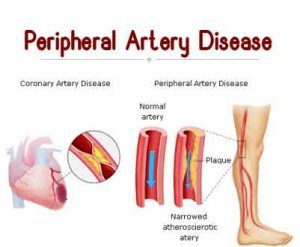
Peripheral arterial disease
March 10, 2021
Admin
Peripheral arterial disease (PAD) is known as a condition where by the blood flow in the limb arteries are obstructed . Commonly, the legs are the most affected. These arteries are obstructed due to plaque deposits that restrict blood flow through the peripheries. Although blood flow may be also restricted by deep vein thrombosis, which may be a blood clot that occurs in the periphery of the limbs
Aetiology
The most common cause of PAD is atherosclerosis, similarly, they share the same risk factors: smoking, diabetes, age, hypertension, and hyperlipidemia. Uncommon vascular symptoms, such as vasculitis, thromboangiitis obliterans, popliteal entrapment syndrome, and fibromuscular dysplasis, account for less than 10% of cases. It is estimated that up to 60% of patients with PAD will have ischaemic heart disease, and 30% have cerebrovascular disease.
Risk Factors
Cigarette Smoking-Cigarette smoking increases the chance of having PAD by seven-fold
Diabetes- Diabetes Mellitus leads to a two-to fourfold increase in risk of cardiovascular events
Age-The risk of PAD increases as the population approaches the age of 50. It has been reported that PAD affects 0.9% of 40-49 year olds and increases to 14.5% of 70 year olds and above .Studies also have shown that men are the target population of PAD
Gender- TASC II guidelines conclude that men are affected at a younger age than women. However, overall there is no clear distinction in risk.
Hypertension-Hypertension can be a risk for developing PAD.
Symptoms
-claudication
– burning and aching sensation in legs
-Occlusion or stenosis of the aorta commonly causes bilateral buttock, thigh, and calf claudication.
Clinical Manifestations
- Non-healing wounds on legs or feet
- Unexplained leg pain
- Pain on walking that resolves when stopped
- Pain in foot at rest made which worsens with elevation
- Ulcers
- Gangrene
- Dry skin
- Cramping
- Aching
Physiotherapy Management
- Supervised treadmill exercise improves treadmill walking performance in patients with PAD.
- Supervised treadmill exercise has greater benefit on treadmill walking performance than home-based walking exercise.
- Home-based walking exercise interventions that involve behavioral techniques are effective for functional impairment in people with PAD and improve the 6-min walk distance more than supervised treadmill exercise.
- Upper and lower extremity ergometry improve walking performance in patients with PAD and improve peak oxygen uptake.
- Lower extremity resistance training can improve treadmill walking performance in PAD, but is not as effective as supervised treadmill exercise.
-
AT our Physiotherapy centre in Gurgaon we have got the best team of physios who are specialised in advance techniques.
For more info contact our best team of physiotherapists on www.dynafisio.com or call us at 8929294515